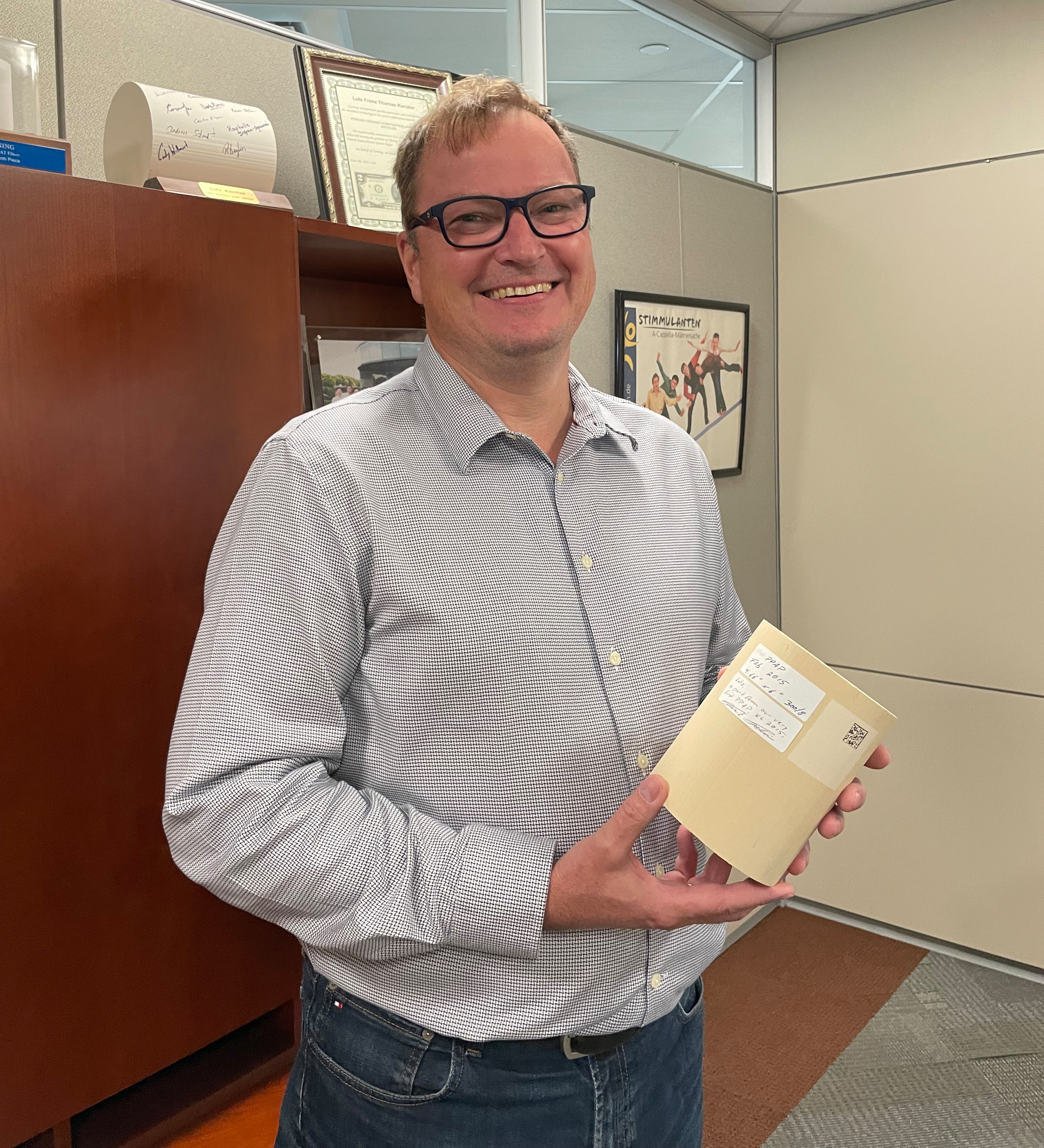Lutz Kercher, division vice president & commercial director with one of first gasoline particulate filters made in Kaiserslautern, Germany.
Innovation is a vital component of Corning Environmental Technologies history. As Corning celebrates 50 years of cleaner air, we look back at some pivotal moments in our businesses journey to 50 million gasoline particulate filters sold worldwide.
The story of Corning’s gas particulate filter begins with an observation of an industry trend in the early 2000s: direct injection engines. The new engines provided better fuel efficiency and more power. But the benefits came with a downside: tons of fine particulates, also known as PM2.5, entered the atmosphere.
Surely, Corning could invent a solution.
Back in 1978, Corning scientist Rod Frost had invented the diesel particulate filter (DPF) but for about the next 20 years, the filters were only used for diesel engines running in confined spaces, like mining vehicles. But as direct injection engines became more popular, regulators targeted particulate emissions as well as gaseous emissions. Strict limits were set in Europe and China.
Our engineering team wasn’t sure how Corning’s particulate filter would perform in a gasoline car environment. Would it impact drivability or performance? Would it filter the smaller particulates?
“Back then, gasoline particulates were known, but it just wasn’t clear how to handle the issue,” said Dr. Thorsten Boger, commercial technology directory light-duty, Corning Environmental Technologies. “We started actively working on solutions early on. Still, by 2013 and 2014 not everyone was convinced that we were taking the right approach. Listening to those concerns helped us move into the right direction.”
Introducing a novel technology
A dedicated core team worked towards a solution. In 2014, Corning publicly announced the successful development of a unique filter product designed to capture gasoline particulates without sacrificing engine performance.
Gasoline particulate filters (GPFs) have a similar honeycomb structure as DPFs but are exclusively made with a ceramic cordierite material with a wall microstructure specifically engineered for gasoline exhaust. The porosity of this material can be higher than in a DPF and is designed to allow for the filtration of finer particulates (PM2.5 or down to 10nm) prevalent in gasoline vehicle exhaust. These filters can withstand high temperatures >1100°C (2000°F) and are thermal shock resistant to allow for rapid heat-up on frigid days.
“We wanted to prove that we could define and lead this market,” said Lutz Kercher, division vice president and commercial director, Corning Environmental Technologies. “To solve a problem that hasn’t been solved before, that was my motivation.”
In 2016, Corning® DuraTrap® GC filters were officially launched and kickstarted an exciting new chapter in Corning’s history of serving the auto industry.
The market for vehicles with gasoline direct injection engines grew rapidly to about a quarter of worldwide passenger vehicle sales. New Euro 6c and China 6 emissions standards went into effect in 2017 and 2020, respectively. Several global automakers announced plans to equip vehicles with GPF. Now, Corning had to ensure that sufficient manufacturing capacity was in place to deliver the promised goods.
Ramping up manufacturing capabilities
Global collaboration between development, business, program, and manufacturing teams became critical for success. Corning Environmental Technologies quickly scaled up with huge manufacturing investments in Germany and China.
The facility in Kaiserslautern, Germany expanded its footprint with new production lines and state-of-the-art equipment dedicated to DuraTrap® GC filters. The Shanghai plant expansion was the first step of a phased investment approach for DuraTrap® GC filter production in China. In 2019, Corning Environmental Technologies celebrated the grand opening of a completely new facility in Hefei, China.
The impact: We can all breathe easier
Since 2006, Corning’s DPF and GPF for light- and heavy-duty applications have captured more than 1 million tons of particulate matter from vehicle exhaust.
Modern internal combustion engine vehicles can reach near-zero levels of emissions if equipped with advanced emissions control technologies. In fact, on-road measurements show that the tailpipe particulate emissions for vehicles with filters can be lower than the ambient concentrations of highly polluted cities. In some places, the exhaust coming out of your car is cleaner than the air around it.
There’s always potential for improvement
Corning’s new gasoline particulate filters went from successful launch to proven technology used in millions of cars. And yet the spirit of innovation was kept alive in business, engineering, and development teams spread across the globe and next generation products followed in subsequent years. Someday soon we hope to see GPFs on cars in the US, too.
Fine particulates (also known as PM2.5) are about 30 times smaller than the diameter of a human hair and can make their way deep into the lung, causing a range of cardiovascular health effects that could spread to other organs.
Plugged channels force the gas to flow across the porous walls, which collect soot and ash.





